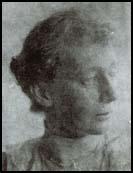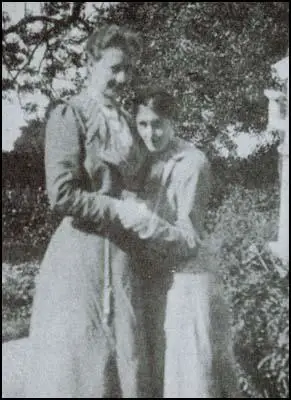Violet Dickinson

Violet Dickinson, the daughter of Edmund Dickinson, was born in Frome in 1865. Her grandfather was Lord Auckland, the Bishop of Bath and Wells. She was considered a tomboy as a child and by the time she reached the age of fifteen she was six feet tall. Her family were extremely wealthy and she never needed to work.
According to Hermione Lee: "She was that late-Victorian type: a well-connected, benevolent and helpful single gentlewoman with attachments and visiting rights in a number of stately homes... She looked odd: extremely tall, and plain, badly dressed, and ramshackle.... She was known for her generosity, her sympathy, her good works and little gestures... She visited the London Hospital and had an interest in mentally ill women with a criminal record... From 1899 to 1900 she was Mayoress of Bath. All this was the fruit of a respectable, establishment Quaker background."
In 1897 she visited the home of Leslie Stephen for the first time. Stephen wrote that: "She (Violet Dickinson) has taken a great fancy to all the girls, specially to Ginia (Virginia)". In 1902 Violet Dickinson began corresponding with Virginia Stephen. The two women went on holiday together to Venice, Florence and Paris. Virginia who was seventeen years her junior accused Violet of being a "dangerous woman" who was "not at all the right kind of influence over young girls". Vanessa Curtis, the author of Virginia Woolf's Women (2002) has pointed out that "Violet was full of happiness, brusque common sense, jollity and optimism, all of which were qualities much needed and admired by the young Virginia."
Virginia commented on her new friend: "She is 37 and without any pretence to good looks - which humorously she knows quite well herself and lets you know too - even going out of her way to allude laughingly to her grey hairs, and screws her face in to the most comical grimaces. But an observer who would stop here, putting her down as one of those cleverish, adaptable ladies of middle age who are welcome everywhere and not indispensable anywhere - such an observer would be superficial indeed."

Vanessa Curtis has argued that it is difficult to know if the two women had a sexual relationship. However, she points out that in July 1903 Virginia wrote to Violet that "it is astonishing what depths - what volcano depths - your finger has stirred." On another occasion Virginia told Violet that she had a double bed ready in anticipation of her visit to join her on holiday. Curtis goes on to say that "regardless of the question marks that still hang over the exact nature of their early relationship, there can be no denying that Violet was the first true emotional and physical love of Virginia's early adult life."
Leslie Stephen died of cancer on 22nd February 1904. With both her parents dead, Virginia Stephen became even closer to Violet. Violet became a firm believer in Virginia's literary talent and introduced her to Margaret Littleton, the editor of the women's supplement of The Guardian. As a result of this meeting, Virginia was commissioned to write an article on Charlotte Brontë.
On 30th August, 1908, Virginia wrote to Violet: "Supposing we drift apart, in the next three years, so that we meet and remember our ancient correspondence." Hermione Lee, the author of Virginia Woolf (1996), has argued that "Virginia's intimacy with Violet was playfully erotic from the beginning of their correspondence. The teasing jokes, the demands for attention, the confiding of secrets, were part of an extortionate appeal for petting and mothering. Violet was her woman." Lee points out that Dickinson played an important role in her writing: "She used Violet as her sounding-board for her evolving ideas about how to live, how to talk and how to write."
After her marriage to Leonard Woolf, Violet Dickinson saw very little of Virginia Woolf. However, they continued to write regularly. On 8th December 1936 Virginia wrote: "All I beg of you, is don't let anybody else read those letters". Virginia destroyed the letters from Violet but she kept hers and they were found when she died in 1948.
.
Primary Sources
(1) Hermione Lee, Virginia Woolf (1996)
She was that late-Victorian type: a well-connected, benevolent and helpful single gentlewoman with attachments and visiting rights in a number of stately homes... She looked odd: extremely tall, and plain, badly dressed, and ramshackle.... She was known for her generousity, her sympathy, her good works and little gestures... She visited the London Hospital and had an interest in mentally ill women with a criminal record... From 1899 to 1900 she was Mayoress of Bath. All this was the fruit of a respectable, establishment Quaker background.
